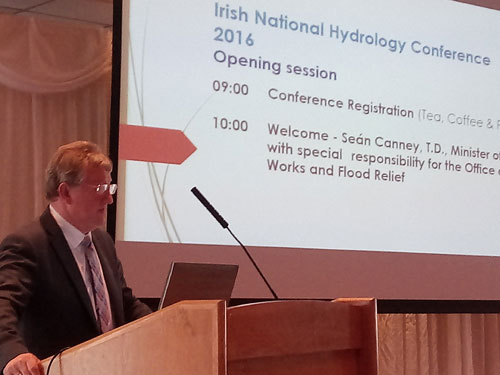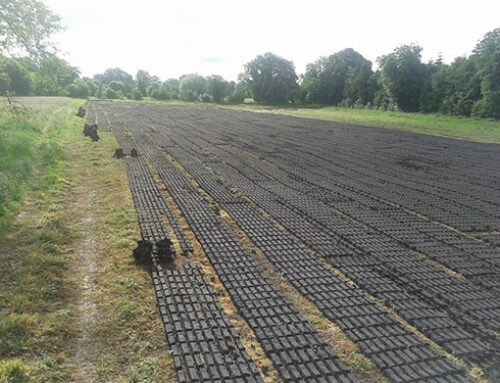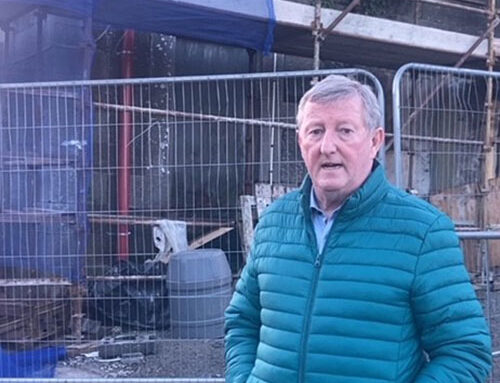This morning (15th November) I addressed the National Hydrology Conference 2016 which took place in the Hodson Bay Hotel, Athlone.
I opened my remarks by thanking the OPW and the Irish National Committees of the International Hydrological Programme and the International Commission on Irrigation and Drainage for organising the event.
During the course of my speech, I said, ‘Last winter was the worst winter on record with rainfall levels at 189% above normal and rivers in many cases recording their highest ever levels. These exceptional flood events brought home to everyone the devastating impact that flooding can have on people’s lives. As Minister of State for the Office of Public Works and Flood Relief, I can assure both you and the general public that the OPW is working as hard as possible to address in an effective and sustainable way the most significant flood risk in the country. At the core of the OPW’s work is the objective of reducing, to the greatest extent possible, the level of flood risk to people, property, infrastructure and the environment.
‘Planning to tackle flood risk requires hydrological expertise and knowledge. Today is an opportunity to share with you the Government’s investment, plans and preparations to tackle flood risk and to emphasise the importance of your work.
‘Ireland is more prepared than ever to tackle flood risk from the significant investment being made to tackle flooding. This investment includes:
• the 37 major flood defence schemes completed since 1995 providing protection to over 7,000 properties,
• a further 5,000 properties being protected from localised flooding through almost 600 projects approved under the OPW’s Minor Works scheme, and
• 650,000 acres of agricultural land are protected through the programmed maintenance of 11,500 km of river channels (including 800 km of embankments) by the OPW under the Arterial Drainage Acts.
‘Since last winter, the OPW has accelerated its resources to complete major flood defence schemes. This year there is a record number of 12 major schemes at construction and a further 23 at design or development stage.
‘The Government investment in capital works of €480m since 1995 is yielding significant benefit in terms of protecting 12,000 properties. The economic benefit to the State in terms of flood damages and losses avoided is estimated at some €1.2 billion.
‘Dutch experts have benchmarked our approach to flood risk management and concluded that Ireland is in line with international best practice and is well on track.
‘As well as the security to families and businesses, this investment is yielding positive returns in terms of availability of flood insurance cover that has increased to up to 89% in protected areas.
‘The OPW and the Department of Finance are continuing to engage, now on a quarterly basis, with Insurance Ireland. The insurance industry and the State are working jointly to explore further means to increase insurance availability. This year I secured a commitment from the industry to consider the risk it currently associates with demountable defences and the OPW is collating the detailed information sought by the industry to that end.
‘In Ireland the Catchment Flood Risk Assessment and Management (CFRAM) programme is the principal vehicle for implementing national policy on flood risk management and to deliver our requirements under the EU Floods Directive.
‘Since 2012, we have completed extensive hydrological analysis in 300 areas that were identified as being at potentially significant risk from flooding, 90 of which are coastal areas. This has involved:
• detailed modelling and mapping in each of the 300 Areas for Further Assessment (AFAs), including surveying and modelling of approximately 6,500 km of watercourse and 9,400 square kilometres of floodplain, and
• the production of approximately 40,000 individual flood maps, including maps of flood extent, depth, ‘risk-to-life’ and other risk, covering three probabilities of flooding.
‘The OPW has worked in partnership with the Local Authorities and through our engineering consultants to complete the biggest ever flood risk planning exercise undertaken in this country.
‘Feasible flood relief measures have now been identified to provide protection to almost all properties assessed at risk from flooding within these at risk areas. The details are set out in 29 draft Flood Risk Management Plans which I have published since July this year for public consultation.
‘The OPW has and is continuing to work with communities. Nearly 500 public consultation days have been held on the CFRAM Programme. At these events, the CFRAM teams have presented the maps, issues, options and proposed measures for discussion with people, face-to-face, in their own communities. People’s views have been taken on board, and have helped form what’s now proposed in the draft plans.
‘The proposed measures in the Plans have been taken to outline design and will reduce the time needed to implement the flood defence schemes in the future. In some cases, this may reduce the average time to complete schemes by up to 2 years.
‘These Plans are a major step forward to help Government make informed investment decisions on flood risk management. The Government’s commitment to continue support of flood relief is underlined in the provision of €430 million to Flood Risk Management in the Capital Investment Plan 2016 to 2021. The annual allocation for flood defence works will more than double in the next five years from €45m to €100m.
‘The Flood Risk Management Plans emphasise the importance of non-structural measures and supports the whole of Government approach adopted to tackle flood risk management.
‘I have been chairing the Interdepartmental Flood Policy Co-ordination Group. Last week the Group’s progress report was approved by Government. The Government noted progress on the broad range of policies and measures being considered including the Shannon Flood Risk State Agency Co-ordination Working Group has agreed to trial lowering lake levels in Lough Allen and also to evaluate the benefits of localised dredging and any future piloting to remove pinch points along the Shannon, as a further commitment to enhance co-ordinated activities by the relevant State Agencies. The Working Group is building on the existing work and commitment of all the State Agencies involved in flood risk on the Shannon. The Group is solutions focused and will monitor the delivery of the Flood Risk Management Plans for the Shannon.
• The Government noted progress with the pilot projects to inform any future Government measures to support Individual Property Protection.
• The implementation plan for the establishment of the National Flood Forecasting Service within Met Éireann over the coming five years has been agreed and work to commence the service has begun.
• The risk of flooding from turloughs is being addressed through the investigation that has commenced between the OPW and Geological Survey Ireland.
‘In addition I have secured €2m for the introduction of a once-off targeted voluntary homeowner relocation scheme. The ongoing work to identify and prioritise homeowners, and the review of the necessary administrative arrangements, will allow me appraise Government and subsequently make initial contact with a small number of targeted homeowners towards the end of this year.’
Concluding, I again thanked the organisers and said that I was delighted to have had the opportunity to share with those present the importance of the work on Ireland’s flood risk management programmes and plans.
National Hydrology Conference 2016
By Seán Canney|
2017-01-18T09:19:53+00:00
November 15th, 2016|Blog, Farming, Flood Relief, Galway East, Homepage, Latest News, National, O P W|0 Comments





